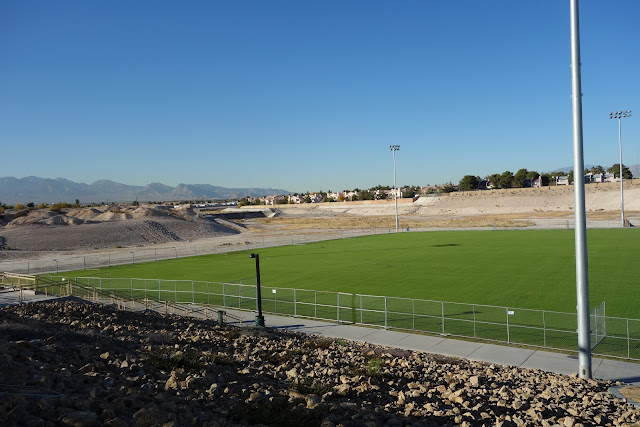My Favorite Places
Charlie Frias Park, Las Vegas, Nevada
 |
| (Image Information: photo of Charlie Frias Park by Kennejima found on Flickr) |
Charlie Frias Park was my local running spot and my go-to place when seeking solitude and moving-meditation. With a 1200-meter paved track, open green fields, views of the great American Southwest desert mountains, and spectacular post-run sunsets, it’s no secret what kept drawing me back to this park.
 |
| (Image Information: personal photo from Dec 2019) |
Even in the middle of the desert, the municipality keeps the fields well-watered and ready for use by dog walkers, practicing athletes, and vagabonds alike.
A typical view during my final lap.
And, at times, I’d conclude my run, take a deep breath of fresh air, and admire
breathtaking sunsets like this—where no filter was needed, ever.
Nablus, West Bank
 |
| (Image Information: personal photo of Nablus from Nov 2018) |
Nablus is a historic valley city situated in Occupied West Bank, about an hour and half drive from Jerusalem. After living among the some of the most welcoming and generous people for several months, Nablus became my home away from home. Despite common western belief, all three Abrahamic religions can be found and practiced peacefully in this Palestinian city with churches and mosques scattered throughout and the Samaritan temple on Mount Gerizim. An average day included strolling through the lively Old City Market, sipping bottomless Arab coffee and/or sweet, sage-infused, Ahmad tea, munching on delicious Levantine food, puffing on mint-flavored shisha, and possibly playing at least a dozen hands of Rummy. Unfortunately, Nablus houses one of the most congested and over-populated UN refugee camps with more than 30,000 men, women, and children living within only 1 km² (less than 1 square mile).
A quiet corner of the ancient Nablus Old City. Flags are hung in anticipation for the celebration of Mohammed’s birthday.
 |
(Image Information: personal photo from Oct 2018)
|
All the able Samaritan men ascend to the top of Mount Gerizim, reciting prayers in Ancient Hebrew during the annual Sukkot ritual celebration.
Appreciating the mountaintop sunrise after witnessing the traditional
Samaritan Sukkot rituals and pilgrimage, which started at 3AM.
Samaritan Sukkot rituals and pilgrimage, which started at 3AM.
 |
(Image Information: personal photo from Oct 2018)
|
Musakhan (pronounced Moo-Saw-Hawn) is a traditional baked Palestinian dish made from special bread called taboon, topped with drizzles of olive oil, thinly sliced onions, tender chicken, sliced almonds or pine nuts fried in olive oil, and most importantly, Sumac, a tangy Arab spice.
 |
| (Image Information: personal photo from Dec 2018) |
Nablus is famous for its style of Knafeh (a traditional Arab dessert) made with semolina dough, filled with a special white cheese, doused in sweet syrup, and topped with ground pistachios. It was tempting to eat it everyday, and I have yet to find Knafeh Nablusi this delicious anywhere else.
To finish, here are some spectacular Nablus sunsets:
 |
| (Image Information: personal photo from Sept 2018) |
 |
| (Image Information: personal photo from Oct 2018) |
 |
| (Image Information: personal photo from Sept 2018) |




What wonderful pictures, Alisha! And how great that you have been Nablus: wow! And seriously: KNAFEH. I had eaten knafeh in Syria, but I didn't realize that there was this special Knafeh Nablusi... now I know! Just as there are so many religions that have found their home in that space over the millennia (thank you for sharing those Samaritan Sukkot pictures; again: wow!), India is also a place that is home to so many religions. The focus of the class is on the epics which are Vaishnavite (although that's... complicated), but we start off with some Buddhist stories too, since Buddhism was taking shape at the same time as the epics, both manifestations of what you could call Dharmic religions. Anyway, thanks again for these great pictures, and I hope you will enjoy learning about India and its traditions in this class.
ReplyDelete